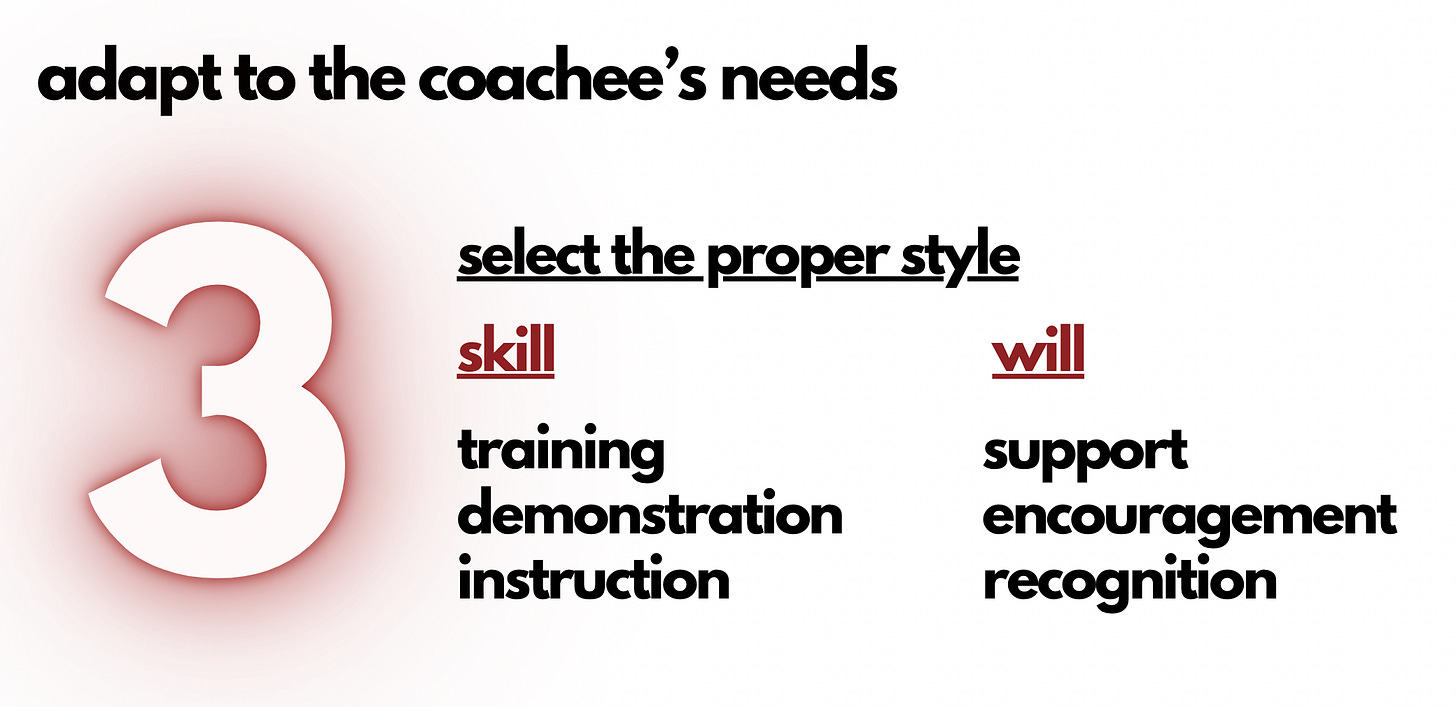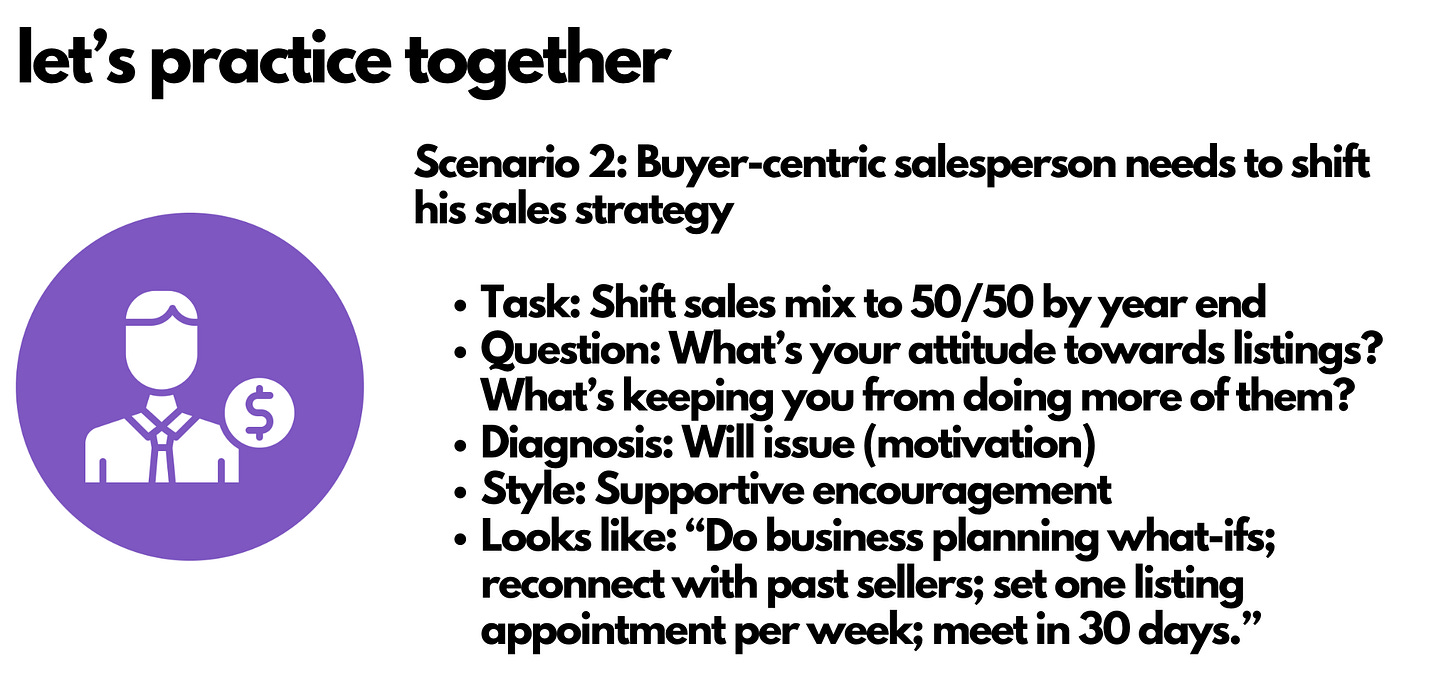Thanks to everyone who attended today’s TLC Deep Dive about the Situational Leadership Model. There is a science behind good coaching and we’ve taken a Deep Dive into the relationships and processes it takes to have effective and successful coaching. Here is the recording, session notes and resources.
Next TLC Coaching Call:
Monday, July 22, 2024 @ 9 AM PST / 12 PM EST
What we covered:
Identify the needs of coaches and coachees
The essential situational leadership coaching model
Practice scenarios to master this process over time
My top tips for conducting effective and successful coaching sessions
What Situational Leadership IS and IS NOT
Situational Leadership IS a flexible framework that enables the coach to meet the coachee’s needs or situations to help them grow.
Situational Leadership IS NOT a fixed routine of tasks that someone should copy/follow in order to develop skills or achieve a certain level of success. That approach is usually called “training” rather than coaching.
As leaders, we’re called to help people grow and develop in different ways. Sometimes that looks like training, as they learn new skills, strengthen knowledge, or build awareness of tools they could use to further their business.
However, when we are called to coach someone, there is another element to the relationship. Coaching is a form of partnership with them, to achieve a goal with a combination of training and support.
It’s important to expect that not everyone is ready to be coached. There are certain needs and criteria for both coach and coachee that must be met first.
Identifying the Needs of Coaches and Coachees
Coaches Need:
Rapport: They need to build a relationship with the coachee that establishes trust, integrity, and commitment to the coachee.
Versatility: Everyone learns at different rates and styles. Coaches need the versatility to adapt to the needs of the coachee to ensure the coachee’s growth.
Patience: Every coachee will run into stumbling blocks or challenges, so it’s important for coaches to slow down, ask questions, and allow the coachee to navigate through those challenges, rather than solving the problem for them.
Courage: Coaches must be willing to push the coachee beyond their comfort zone, to convey the greatness they see in them first, and offer them safety and confidence to dream.
Accountability: The coach must have accountability — to count up the coaches performance and evaluate their efforts. Meanwhile, the coachee takes responsibility for their actions, commitment and outcomes.
Coachees Need:
Trust: Anyone being coached must trust the system, trust the process, and trust the coach has their best interests at heart.
Openness: Coachees must be open to receiving ideas and assistance, trying new things, and acceptance of small risks.
Stamina: Coachees must put in the time and see things through; and be fully committed to the process.
Resilience: Coachees must be willing to stick with the process, even if they experience correction or stumble as they improve.
Responsibility: Coachees always drive the session, show up on time, and complete the homework and apply the direction of their coach.
The relationship between the two roles is a partnership between the coach and coachee to have a successful coaching experience. As coaches, we show up seriously invested in the coachee. We must have the right attitude and mindset.
Most importantly, coaches must remember:
Coaching is something you to WITH people, not TO people
3 Steps to the Situational Leadership a Coaching Model
1. Establish the goal / task
First, coaches always help people achieve a specific goal or task. We’re not doing “therapy” or trying to fix the “whole” person. If we’re going to be effective coaches, we always start with a SMART goal for each coaching effort. This means identifying skills, tasks or outcomes that are specific and measurable, attainable and reasonable, and confined to a timeframe.
Notice how specific and concrete and measurable all of these SMART goals are, compared to the generalized “wish list” in parentheses that most people express. As a coach, do not proceed until you can get SMART with your coachee.
2. Diagnose the “situation”
As my friend and Executive Coach Mike Staver says, “Prescription before diagnosis is malpractice.” It’s one of the most important parts of the process. We can’t offer solutions until we understand the situation the person is dealing with — and what a good outcome should look like.
When diagnosing the situation, assess two factors: The Skill and the Will of the person being coached.
Are they suffering from a lack of skill (ability, knowledge, experience) to achieve the goal? Or are they lacking the will (interest, motivation, or confidence) to take actions they already know how to perform?
By asking lots of questions, you’ll be able to assess the two factors to determine what “prescription” to offer. Here are some questions to diagnose each factor:
Skill: Have you done this before or something similar? Have you trained the process already? Can you use the system/tool? What happens when you try to do this now?
Will: Why do you want to do this? What will you achieve if you do this? What’s holding you back? How confident are you in your ability today?
Based on your diagnosis, the coach adapts the proper style (the prescription) to meet the coachee’s specific needs.
3. Select the proper style (prescription)
Coaches adjust their approach based upon the diagnosis, not their own personal preferences or needs.
When discussing the style you intend to use as a coach, don’t keep it a secret. Explain how you intend to act and what that will look like. Collaborate with the coachee and make adjustments until you come to agreement on the approach. (If not in agreement, take the coachee’s lead until you evaluate progress.) Then explain the steps, the cadence of accountability, the milestones and expectations of the style you will use.
If the person has a skill problem, use techniques that focus on training, demonstration and instruction. Give them direction. Provide lists, scripts, procedures, and tools. Your approach includes technique, assessment and evaluation of their application of your directions.
If the person has a will problem, switch to techniques that provide support, encouragement and recognition of progress. Focus on building their confidence. Celebrate small wins. Your approach includes motivating, checking-in and being present in their efforts, without directing their actions.
Let’s Practice Together
Practice makes perfect with the process, so I have included some practice scenarios you can download and work through to strengthen your ability to assess skill/will and diagnose the situation. Here’s an example (watch the recording to watch me go through the whole practice scenario).
👇Scroll down to download more scenarios to practice on your own.
My Top Three Tips for Conducting Effective Coaching
Here are some ideas for conducting coaching sessions that consistently deliver results.
Keep a well-organized coaching session structure:
Start and end on time
Validate the goal each time and determine results so far
Let the coachee drive the agenda
Keep everything confidential
Celebrate wins and establish next steps




















